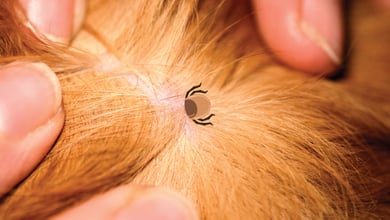Zoonotic diseases can be transmitted between species, posing risks to our beloved pets and our own well-being. This guide will explore common zoonotic diseases in dogs, their transmission, symptoms, diagnosis, and preventive measures.
By staying informed, practicing good hygiene, and seeking guidance from veterinary professionals, we can create a healthier and safer environment for all.
What Are Zoonotic Diseases in Dogs?
Zoonotic diseases, also known as zoonoses, are illnesses that can be transmitted between animals and humans. Although a wide range of zoonotic diseases are prevalent worldwide, it is reassuring to know that many of these illnesses are extremely rare.
Zoonotic diseases can be transmitted directly from animals to humans or between animals. This can happen through the air (like influenza) or through bites and contact with infected saliva (like rabies).
Indirect zoonoses, on the other hand, require an intermediate host or vector for transmission. These can be ticks, mosquitoes, fleas, or other animals that carry and spread the disease. These intermediates act as bridges between the original animal host and the recipient, facilitating the spread of the disease.
Related reading: Flea and Tick Prevention: A Complete Guide
Common Zoonotic Diseases in Dogs
Dogs with Zoonotic disease can pose a risk to human health. Here are some examples and how they can be transmitted:
- Bacterial infections (e.g., Leptospirosis, salmonellosis) spread through contaminated urine or feces.
- Viral zoonotic diseases (e.g., rabies, canine influenza) are transmitted through bites or close contact with infected secretions.
- Tick-borne diseases (e.g., Lyme disease, ehrlichiosis) are transmitted through tick bites.
- Parasitic infections (e.g., toxoplasmosis, giardiasis) can be acquired from contact with infected feces.
- Fungal zoonotic diseases (e.g., Ringworm) can be contracted through direct contact with infected skin or hair.
Signs & Symptoms of Dogs with Zoonotic Diseases
Zoonotic diseases in dogs may show signs such as:
These symptoms can vary depending on the specific disease. If you notice any of these signs, seek veterinary care promptly for an accurate diagnosis and appropriate treatment.
Diagnosis of Canines with Zoonotic Disease
To diagnose Zoonotic disease in dogs, the vet will ask about their travel, and vaccinations, and do a thorough physical exam. They may also employ a range of diagnostic tests to pinpoint the specific disease, such as blood work, cultures, X-rays, and ultrasounds.
Treatment of Dogs with Zoonotic Disease
Once a diagnosis is made, the treatment approach will depend on the identified disease. Treatment options may include the administration of antibiotics, anti-parasitic drugs, or anti-fungal medications. In some cases, hospitalization and intravenous fluids may be necessary, along with symptomatic care for associated conditions like vomiting or diarrhea. Additionally, your veterinarian may prescribe analgesic medication to address any pain or discomfort your dog may be experiencing.
It's important for pet parents to follow their veterinarian's advice and stay connected through regular checkups. This helps track progress, make necessary adjustments to the treatment plan, and ensure a successful recovery while minimizing the risk of spreading the disease.
Home Care for Zoonotic Diseases in Canines
Even though not all animals carrying zoonotic diseases pose a significant risk to humans, it's crucial to prioritize good hygiene and sanitation practices as a precautionary measure when handling pets and their waste. Understanding the disease and how it spreads is key to effective home and preventative care. Make sure to stay up to date with regular veterinary check-ups to stay informed.
How to Prevent Zoonotic Diseases in Dogs
You can minimize the risk of zoonotic spread with your dog by practicing these simple hygiene precautions:
- Wash your hands thoroughly after handling your pet and their waste, and keep your living area and yard clean and tidy.
- Make sure your furry friend is up to date on their vaccinations that protect against pesky parasites.
- When cleaning up after your dog, use gloves and a plastic bag to dispose of their waste.
- Use tick prevention products and regularly check your pet for ticks, especially after outdoor activities.
- Keep up with your dog's grooming routine to maintain their coat care and overall hygiene.
- Take your pet to routine veterinarian check-ups to ensure their overall health and catch and prevent any potential issues early on.
Conclusion
To protect both dogs and humans, it is important to understand how zoonotic diseases are transmitted and how to prevent them. Practicing good hygiene habits and following your veterinarian's advice can minimize the risk of zoonotic diseases. Stay proactive, stay protected.
Frequently Asked Questions
What zoonotic diseases can be spread by dog feces?
Zoonotic diseases that dog feces can cause include parasites like roundworms, hookworms, and Giardia, as well as bacterial infections like Salmonella and Campylobacter.
What are some examples of zoonotic diseases in cats and dogs?
Zoonotic diseases that can be transmitted from cats to humans include toxoplasmosis, cat scratch disease (CSD), rabies, and ringworm. From dogs to humans, zoonotic diseases include rabies, leptospirosis, and Lyme disease.
What zoonotic diseases can dogs get from humans?
Although extremely rare, there has been speculation that some influenza strains may be able to be passed to dogs, but research is still being conducted.






